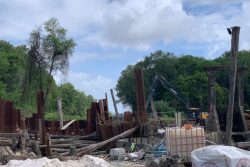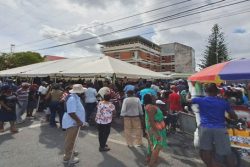(This is the first in a 10-part series)
This series of articles is intended to look at some of the issues surrounding Guyana’s bid for funds from the World Bank-administered Forest Carbon Partnership Fund (FCPF) and from Norway, and for the President’s Low Carbon Development Strategy (LCDS). While most of the government information is on the government’s LCDS website – www.lcds.gov.gy – that site is still under development at the time of writing and it is not possible to read about the feedback from the government’s traditional outreach meetings with some Amerindian communities in the hinterland. In contrast, the information developed by the Guyana Forestry Commission (GFC) for the bid for FCPF funds is not linked to the LCDS website, is not mentioned on the GFC’s own website, but is available on the World Bank’s FCPF website – http://www.forestcarbonpartnership.org/fcp/ Node/179.
In this series I want to draw attention to the high level of uncertainty about the data on which the Government of Guyana is building up high hopes in the population. While the GFC has been cautious in emphasizing gaps in knowledge and the need for using FCPF funds to fill those gaps, the LCDS jumps into the more speculative questions about how we should spend unprecedented amounts of external funds for climate change adaptation. The LCDS glosses over the fact that we have no assurance of such funds being agreed. So far as I can tell, President Jagdeo’s LCDS is not among those schemes which are under international discussion in the context of the United Nations Framework Convention on Climate Change in advance of the 15th Conference of Parties which is scheduled to agree on a post-Kyoto protocol on climate change mitigation and adaptation, at Copenhagen in December 2009; see www.littleREDDbook.org. Guyana is one of 40 nations in the Coalition for Rainforest Nations but the approach being taken by the Coalition is never mentioned in President Jagdeo’s LCDS or in the GFC’s submissions to the FCPF. This isolation from mainstream discussion on climate change options is surely not a good strategy at any time, and especially not at this critical time.
I start by quoting a pair of questions raised more than once at the launch of the LCDS in Georgetown on July 08, 2009, using the wording as recorded on the LCDS website –
“What are the possible negative effects of the strategy? Is US$ 580 million per year accurate and adequate?”
Answer from the government side – “Refer to the annex to the strategy for calculations of the Economic Value to the Nation. Regarding costs of adaptation measures, refer to pages 28/29 of the strategy.”
So the government chose not to respond to the question about possible negative effects; referred to the McKinsey consultancy report extracted into Appendix II of the strategy (see http://www.lcds.gov.gy/images/stories/Documents/LCDS.pdf) ; and referred mainly to the adaptation costs for continued occupation of the increasingly floodable coastal lowlands. The government did not respond to the question about accuracy or adequacy. Clearly, in the vulnerable coastal region, the sky is the limit for adaptation if the intention is to sit tight while the waters rise. The LCDS does not even consider the possibility of a population shift inland to higher drier ground, although this has been done and is being contemplated elsewhere – the move of the capital inland to Belmopan in Belize after Hurricane Hattie in 1961, the current search for a new homeland for the inhabitants of the Maldive Islands in the Indian Ocean, and the evacuation of the population of the Cateret Islands off Papua New Guinea in mid-May this year. Kaieteur News ran an editorial on this subject on June 22, 2009, but there has been as yet no government response.
In this series, we need to consider the forest carbon budget. We could think of this like a stock taking of the tins of sardines in the kitchen cupboard:
► how many tins of sardines do we have in the cupboard now? = how much carbon is contained in our standing forests now?
► how many tins of sardines do we consume, and when? = what are the decreases in the carbon stock due to natural mortality of trees, loss through windstorm and accidental fire, extraction as timber, mortal damage during logging, permanent or long-term destruction through mining, and permanent or short-term loss through sedentary or rotational agriculture?
► how many tins of sardines do we buy and add to our kitchen cupboard? = what are the increases in the carbon stock due to tree growth, expansion of forest area and forest spread?
Some of the international debate about carbon sequestration (net carbon storage) and carbon marketing concerns the net amount of carbon which could be added by extra efforts. These efforts could include:
► afforestation (new forests where forests have not grown naturally in the past);
► reforestation (replacement of previous forest);
► silviculture (making trees grow faster, or survive longer).
That is like adding extra tins of sardines above those that we stock normally in our kitchen cupboard. We could also seek to reduce loss and wastage of carbon by:
► increasing the wind resistance of forests;
► decreasing their susceptibility to fire;
► reducing or eliminating logging by cancelling logging concessions or by restricting logging to those which can operate efficiently with minimum wastage;
► actually enforcing our legislation, rules and guidelines for sustainable forest management;
► using reduced impact logging techniques to minimize careless damage to the forest;
► actually applying the integrated land use planning prescribed in the National Development Strategy in 1996, and so reducing wastage when miners destroy forests before they have been logged intensively;
► preventing wasteful land clearance for low-value or one-time agricultural crops.
A feature of the Guyana Shield forests stretching from Venezuela eastwards across Guyana to French Guiana and Brazil north of the Amazon is the natural infertility of soils derived from ancient rocks which have not been rejuvenated by volcanism or marine transgression. The forests on these soils consist of relatively small trees (compared with rainforest in tropical Africa and southeast Asia) which are naturally slow growing with hard, heavy and durable timbers. In relation to our kitchen cupboard, these forests add carbon slowly and, if left alone, lose carbon slowly. But they are vulnerable to carbon loss through badly planned and poorly executed logging and mining and agriculture, more so than forests on more fertile soils. So in Guyana we should take extra care to plan carefully and to actually apply our land laws and regulations and procedures, fully, objectively and equitably. Compared with other rainforest countries, we have only a small potential for adding “extra tins of sardines” (carbon) to our natural stock, so we need to assess that stock, the gains and the losses with extra care. That assessment is addressed partially in the GFC’s proposals to the FCPF, but so far little concern has been given to the uncertainties about the estimates. I will comment on the estimates in the FCPF proposals and in the LCDS but I welcome observations from readers.
In this series I will look at some of the consequences of the slapdash approaches to land and forest management currently in use in our country, and how those affect our carbon budget. In the next article, I will ask “what is carbon?”




